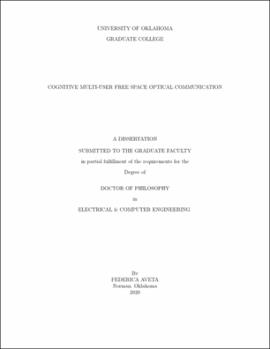| dc.description.abstract | Increasing deployment of terrestrial, aerial, and space-based assets designed with more demanding services and applications is dramatically escalating the need for high capacity, high data-rate, adaptive, and flexible communication networks. Cognitive, multi-user Free Space Optical Communication (FSOC) networks provide a solution to address these challenges. Such FSOC networks can potentially merge automation and intelligence, as well as offer the benefits of optical communication with enhanced bandwidth and data-rate over long communication networks. Extensive research has investigated various designs, techniques, and methods to enable desired FSOC systems.
This dissertation reports the investigation and analysis of novel, state-of-the-art methodologies and algorithms for supporting cognitive, multi-user FSOC. This work details an investigation of the ability of diverse Optical-Multiple Access Control (O-MAC) techniques for performing multi-point communication. Independent Component Analysis (ICA) and Non-Orthogonal Multiple Access (NOMA) techniques were experimentally validated, both singularly and in a combined approach, in a high-speed FSOC link. These methods proved to successfully support multi-user FSOC when users share allocation resources (e.g., time, bandwidth, and space, among others). Additionally, transmission and channel parameters that can affect signal reconstruction performance were identified. To introduce cognition and flexibility into the network, the research reported herein details the use of several Machine Learning (ML) algorithms for estimating crucial parameters at the Physical Layer (PHY) of FSOC networks (e.g., number of transmitting users, modulation format, and quality of transmission [QoT]) for automatically supporting and decoding multiple users. In particular, a novel methodology based on a weighted clustering analysis for automatic and blind user discovery is presented in this work. Extensive experimental analysis was conducted under multiple communication scenarios to identify system performance and limitations. Experimental results demonstrated the ability of the proposed techniques to successfully estimate parameters of interest with high accuracy. Finally, this dissertation presents the design and testing of a modular, multiple node, high-speed, real-time Optical Wireless Communication (OWC) testbed, which provides a hardware and software platform for testing proposed methods and for further research development.
This dissertation successfully proves the feasibility of cognitive, multi-user FSOC through the developed and presented
methodologies, as well as extensive experimental analyses. The main strength of the research outcomes of this work consists of exploiting software solutions (e.g., O-MAC, signal processing, and ML techniques) to intelligently support multiple users into a single optical channel (i.e., same allocation resources). Accordingly, Size, Weight and Power (SWaP) requirement can be reduced while achieving an increased network capacity. | en_US |
